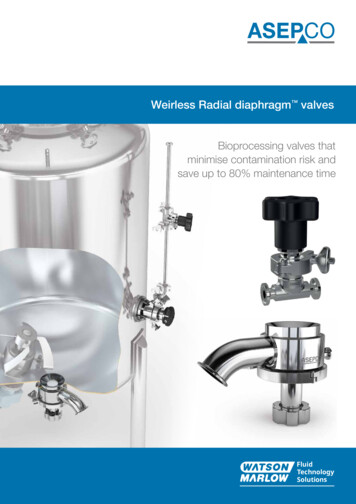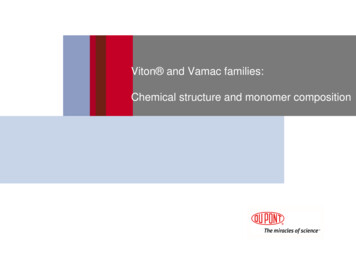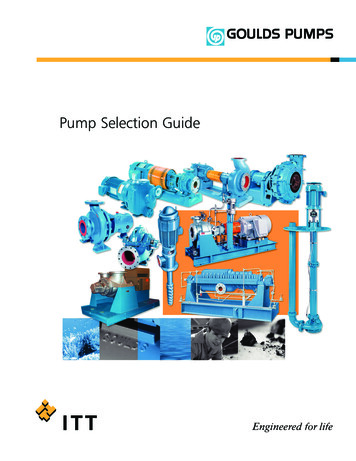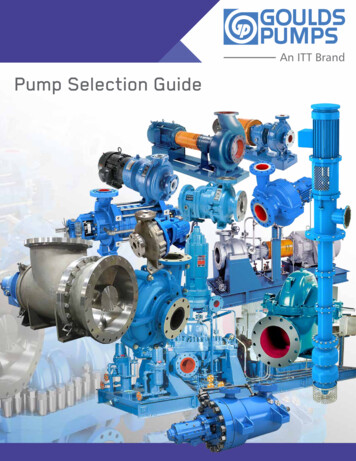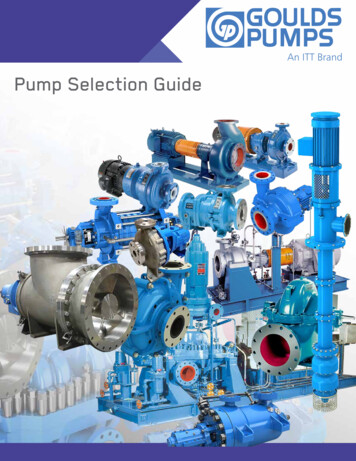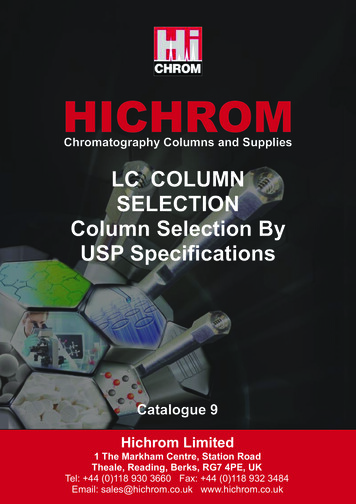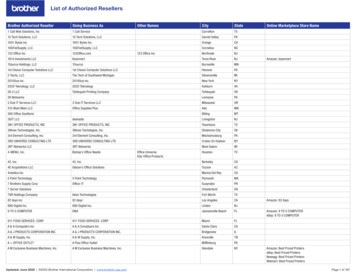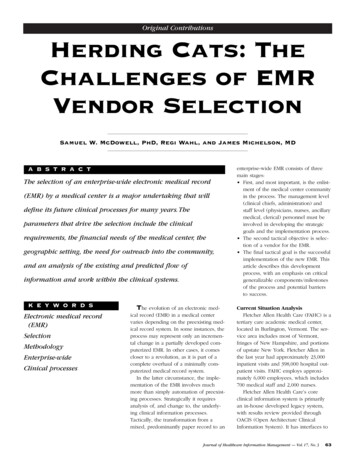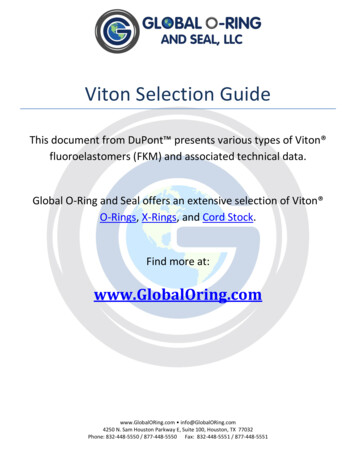
Transcription
Viton Selection GuideThis document from DuPont presents various types of Viton fluoroelastomers (FKM) and associated technical data.Global O-Ring and Seal offers an extensive selection of Viton O-Rings, X-Rings, and Cord Stock.Find more at:www.GlobalOring.comwww.GlobalORing.com info@GlobalORing.com4250 N. Sam Houston Parkway E, Suite 100, Houston, TX 77032Phone: 832-448-5550 / 877-448-5550 Fax: 832-448-5551 / 877-448-5551
DuPont Viton Selection GuideTechnical Information—Rev. 7, July 2010IntroductionDuPont Viton fluoroelastomer was introduced in 1957 to meet the needs of the aerospace industry for ahigh-performance seal elastomer. Since then, the use of Viton fluoroelastomer has expanded to many otherindustries, especially in the automotive, fluid power, appliance, and chemical fields. With over 40 years ofproven performance, Viton fluoroelastomer has developed a reputation for outstanding performance in hightemperature and extremely corrosive environments.Valuable Properties of Viton FluoroelastomerVulcanizates based on Viton provide an exceptional balance of physical property characteristics, includingthe following features: Resistance to temperature extremes:Heat—Compared to most other elastomers, Viton is better able to withstands high temperature, whilesimultaneously retaining its good mechanical properties. Oil and chemical resistance are also essentiallyunaffected by elevated temperatures. Compounds of Viton remain substantially elastic substantiallyindefinitely when exposed to laboratory air oven aging up to 204 C or to intermittent exposures up to316 C. High temperature service limits are generally considered to be:3,000 hr at 232 C1,000 hr at 260 C240 hr at 288 C48 hr at 316 CCold—Viton is generally serviceable in dynamic applications to temperatures of –18 to –23 C. Specialformulations permit its use in static applications down to –54 C. Also, Viton has proven to be satisfactoryfor static seals used under conditions approaching absolute zero. Viton is characterized by its:Resistance to degradation by a greater variety of fluids and chemicals than any nonfluorinated elastomer.Excellent resistance to oils, fuels, lubricants, and most mineral acids.Extremely low permeability to a broad range of substances, including particularly good performance inoxygenated automotive fuels.Resistance to aliphatic, aromatic hydrocarbons that dissolve other rubbers.Exceptionally good resistance to compression set, even at high temperatures.Exceptionally good resistance to atmospheric oxidation, sun, and weather. Excellent resistance to fungusand mold.Good electrical properties in low voltage, low frequency applications.Low burning characteristics; inherently more resistant to burning than other, non-fluorinated hydrocarbonrubbers.
Safety and HandlingAs with many polymers, minute quantities of potentially irritating or harmful gases may diffuse from uncuredDuPont Viton even at room temperature. Therefore, all containers should be opened and used only inwell-ventilated areas. In case of eye contact, immediately flush the eyes for at least 15 min with water. Alwayswash contacted skin with soap and water after handling Viton .Potential hazards, including the evolution of toxic vapors, may arise during compounding, processing, andcuring of the raw polymers into finished products or under high-temperature service conditions. Therefore,before handling or processing Viton , make sure that you read and follow the recommendations in the DuPontbulletin “Handling Precautions for Viton and Related Chemicals.”Compounding ingredients and solvents that are used with Viton to prepare finished products may presenthazards in handling and use. Before proceeding with any compounding or processing work, consult andfollow label directions and handling precautions from suppliers of all ingredients.The Various Families and Types of Viton FluoroelastomerStandard types of Viton fluoroelastomer products are designated as A, B, or F according to their relativeresistance to attack by fluids and chemicals. The differences in fluid resistance are the result of differentlevels of fluorine in the polymer, which is determined by the types and relative amounts of copolymerizedmonomers that comprise the polymer.In general, Viton exhibits outstanding resistance to attack from a wide variety of fluids, including mineralacids and aliphatic and aromatic hydrocarbons. The higher the fluorine content of the polymer, the less will bethe effect, as measured by volume increase, for example. The most significant differences between A, B andF types of Viton , in terms of resistance to volume change or retention of physical properties, are exhibited inlow molecular weight, oxygenated solvents (such as methanol and methyl t-butyl ether).As mentioned above, the fluid resistance of Viton A, B, and F types improves with increasing fluorine levels.This is shown in Table 1 (note the volume increase after aging in methanol at 23 C). As the fluorine contentincreases, however, the low temperature flexibility of the polymer decreases, and a compromise must bemade between fluid resistance and low temperature flexibility of the final vulcanizate.For those applications that require the best performance in both fluid resistance and low temperature flexibilitya number of specialty types of Viton were developed that contain a copolymerized fluorinated vinyl ethermonomer. Polymers that contain this monomer exhibit significantly improved low temperature flexibility,compared to standard types of fluoroelastomer.Viton GLT, introduced in 1976, was the first commercial fluoroelastomer to incorporate this fluorinated vinylether monomer. This polymer provides the same excellent resistance to heat and fluids that is typical of the Atypes of Viton fluoroelastomer. Viton GFLT, like Viton GLT, exhibits significantly improved low temperatureflex characteristics compared to standard types of fluoroelastomer. In addition, Viton GFLT provides thesame superior resistance to fluids that is typical of the F types of Viton fluoroelastomer.Types of DuPont Viton Extreme Fluoroelastomers that contain copolymerized vinylidene fluoride(VF2) are subject to attack by high pHmaterials, including caustics and amines. In addition, standard fluoroelastomers are not resistant to lowmolecular weight carbonyl compounds, such as methyl ethyl ketone, acetone, or methyl tertiarybutyl ether.Viton Extreme ETP-600S is a copolymer of ethylene, tetrafluoroethylene (TFE), and perfluoromethylvinylether (PMVE). This unique combination of monomers provides outstanding resistance to fluids and is anexample of an ETP polymer. The ETP types of Viton exhibit the same excellent resistance to acids andhydrocarbons typical of A, B and F types of Viton . Unlike conventional fluoroelastomers, however, ETP typesof Viton also provide excellent resistance to low molecular weight esters, ketones, and aldehydes. Inaddition, these unique polymers are inherently resistant to attack by base, and thus provide excellentresistance to volume swell and property loss in highly caustic solutions and amines.Additional information regarding performance differences between the various families and types of DuPont Viton fluoroelastomer is presented in Tables 3–6 to assist in selecting the particular grade of Viton that isbest suited for both a given end-use application and for a specific manufacturing process.2
Table 1Polymer Fluorine Content versus Fluid Resistance and Low Temperature FlexibilityStandard TypesSpecialty TypesABFGLT-SGFLT-SETP-SNominal Polymer FluorineContent, wt%666870646767Percent Volume Change in Fuel C,168 hr at 23 C*432524Percent Volume Change inMethanol, 168 hr at 23 C*904059055Percent Volume Change inMethyl ethyl Ketone, 168 hrat 23 C* 200 200 200 200 20019Percent Volume Change in 30%Potassium Hydroxide,168 hr at 70 C*Low Temperature Flexibility, TR-10, C*(Samples too swollen and degraded to test)–17–13–6–3014–24–12*Nominal values, based on results typical of those obtained from testing a standard, 30 phr MT (N990) carbon black-filled, 75 durometer vulcanizate. Theseare not intended to serve as specifications.Curing Systems for Viton FluoroelastomerIn addition to inherent differences between the various types and families of Viton fluoroelastomer, a numberof compounding variables have major effects on the physical property characteristics of the final vulcanizates.One very important variable is the crosslinking or curing system that is used to vulcanize the elastomer.Diamine curatives were introduced in 1957 for crosslinking Viton A. While these diamine curatives arerelatively slow curing, and do not provide the best possible resistance to compression set, they do offerunique advantages. For example, compounds cured with diamines exhibit excellent adhesion to metal insertsand high hot tensile strength.Most fluoroelastomers are crosslinked with Bisphenol AF, a curative introduced in 1970, in the firstcommercial curative-containing precompound, Viton E-60C. Compounds of Viton that use this curativeexhibit fast rates of cure and excellent scorch safety and resistance to compression set.In 1987, an improved bisphenol curative was introduced, which was made available in several differentprecompounds. The modified system provides faster cure rates, improved mold release, and slightly betterresistance to compression set, compared to the original bisphenol cure system used in Viton E-60C andE-430. Additional precompounds of Viton , incorporating this modified curative, were introduced in 1993,including Viton A-331C, A-361C, B-601C, and B-651C. A brief description of all these products can be foundin Table 6.In 1976, efficient peroxide curing of fluoroelastomers was made possible for the first time with the introductionof Viton GLT. The peroxide cure system provides fast cure rates and excellent physical properties inpolymers such as GLT and GFLT which cannot be readily cured with either diamine or bisphenol crosslinkingsystems. In the case of polymers such as Viton GF, GBL-200, and GBL-900, the peroxide cure providesenhanced resistance to aggressive automotive lubricating oils and steam and acids. Generally, vulcanizatesof Viton fluoroelastomers cured with peroxide do not show any significant difference in resistance to otherfluids and chemicals compared to the same polymer cured with bisphenol.In 2003, a series of peroxide-cure types of Viton made with Advanced Polymer Architecture was introduced.These polymers, designated as APA polymers by having an “S” suffix on the product name, incorporate asignificantly improved cure site. As a result, they provide substantially better processing and physicalproperties, compared to the original, non-APA peroxide-cure types of Viton . A comparison of the variousprocessing and physical property characteristics of compounds using the various cure systems is shown inTable 2.3
Table 2A Comparison of Cure Systems Used in Crosslinking DuPont Viton Type of Cure SystemProperty, Processing CharacteristicDiamineBisphenolPeroxide*Processing Safety (Scorch)P-FEEFast Cure RateP-FEEMold Release/Mold FoulingPG-EG-EAdhesion to Metal InsertsEGGCompression Set ResistancePEESteam, Water, Acid ResistanceFGEFlex Fatigue ResistanceGGGRating: E Excellent G Good F Fair P Poor*Luperco 101-XL (trademark of Pennwalt Corporation) and Varox Powder (trademark of R.T. Vanderbilt Co., Inc.) are commonly used.Selecting a Specific Type of DuPont Viton FluoroelastomerInherent Physical Property Differences Between Types/Families of Viton ProductsThe physical properties of vulcanizates based on Viton fluoroelastomers are determined to a large extent bythe type and amount of the filler(s) and curative(s) used in the formulation, and by the temperature andduration of the curing cycle used in their manufacture.In terms of resistance to compression set, low temperature flexibility, and resistance to certain classes offluids, however, some inherent differences exist among the various families of Viton fluoroelastomers. Theseare the result of differences in the relative amount and type of monomers used in the manufacture of thevarious types of Viton fluoroelastomers.The differences in physical property characteristics which exist between various types and families of Viton fluoroelastomer products are outlined in general terms in Table 3.As an example, resistance to compression set is an important property for seals and if this property wereconsidered to be the most important feature for a particular part, then one of the A-types of Viton might bethe best choice for the application. However, if resistance to the widest possible range of fluids is a moreimportant consideration then an F-type Viton fluoroelastomer might well be a better choice for that particularend-use application. Further, if both fluid resistance and low temperature flexibility are equally importantrequirements for maximizing the end-use suitability of a given part GFLT-types of Viton would represent thebest overall choice.Table 3Physical Property Differences Between Types/Families of Viton Products Type of Viton FluoroelastomerResistance toCompression SetGeneral Fluids/Chemical Resistance*Low TemperatureFlexibility**3A13B, GBL-S233F, GF-S3231GLT-S23GFLT-S222ETP-S3131 Excellent—Best performance capability of all types; 2 Very Good; 3 Good—Sufficient for all typical fluoroelastomer applications*See Table 4 for a detailed guide to choosing the best type of Viton fluoroelastomer, relative to specific classes of fluids and chemicals.**Flexibility, as measured by Temperature of Retraction (TR-10), Gehman Torsional Modulus, Glass Transition (Tg), or Clash-Berg Temperature.Brittle-Point tests are a measure of impact resistance only and do not correlate at all with the low temperature sealing capability of a vulcanizate.4
Selecting a Specific Type of DuPont Viton FluoroelastomerDifferences in Fluid Resistance Between Types of Viton ProductsAs in the case of physical properties, different polymer compositions will result in inherent differences withregard to fluid resistance.Table 4 outlines the differences that exist between types of Viton products, in terms of their resistance tovarious classes of fluids and chemicals.Because as certain types of Viton products may exhibit performance that is superior to other types in oneregard, but not quite as good in some other aspect, it is important to consider the requirements of the part tobe manufactured, in terms of both physical property requirements and fluid or chemical resistance needs.Using Tables 3 and 4, the compounder can select the best type of Viton product for a given end-useapplication, based on the best combination of physical property and fluid resistance characteristics.Table 4Differences in Fluid Resistance Between Types of Viton Fluoroelastomer Type of Viton FluoroelastomerABFGBL-SGF-SGLT-SGFLT-SETP-SCure SystemBisphenolHydrocarbon Automotive, AviationFuelsPeroxide11111111Oxygenated Automotive Fuels(containing MeOH, EtOH, MTBE, etc.)NR2121NR11Reciprocating Engine Lubricating Oils(SE-SF Grades)21111111Reciprocating Engine Lubricating Oils(SG-SH Grades)32211111Aliphatic Hydrocarbon Process Fluids,Chemicals11111211Aromatic Hydrocarbon Process Fluids,Chemicals22111211Aqueous Fluids: Water, Steam,Mineral Acids (H2SO4, HNO3, HCl, etc.)32211111Amines, High pH Caustics (KOH,NaOH, etc.)NRNRNR33331Low Molecular Weight Carbonyls(MTBE, MEK, MIBK, etc.)NRNRNRNRNRNRNR11 Excellent—Best choice of Viton type(s) for service in this class of fluid/chemical; minimal volume increase, change in physical properties.2 Very Good—Good serviceability in this class of fluid/chemical; small amounts of volume increase and/or changes in physical properties.3 Good—Suitable for use in this class of fluid/chemical; acceptable amounts of volume increase and/or changes in physical properties.NR Not Recommended—Excessive volume increase or change in physical properties.5
DuPont Viton Product Naming SystemWith the introduction of six improved processing precompounds in 1993, a new nomenclature system wasadopted for Viton fluoroelastomer products. The new system incorporates the following information in aproduct name: Nominal Mooney Viscosity Family type (relative fluid resistance) Relative state of cure (relative level of crosslinking agent present in curative-containing precompounds) An indication of whether the product can be crosslinked using a peroxide cure system An indication of whether the product is a gum polymer or a precompound, which contains a preset,carefully controlled amount of bisphenol crosslinking system.Each character in the product name indicates a specific characteristic as outlined below:1st Character (Letter) Represents the Viton fluoroelastomer family—A, B, F, or ETP. A “G” prefix, in addition to a family prefix, indicates that the polymer can be crosslinked with the peroxidecure system. An “L” designation indicates that the A, B, or F type polymer provides slightly improved low temperatureflexibility characteristics versus other polymers within the same family. An “LT” designation indicates amore significant improvement in low temperature performance criteria.nd2 Character (Number)Represents nominal Mooney Viscosity of the product—ML 1 10 at 121 C.rd3 Character (Number)Represents the relative level of curative in a precompound on a scale of 101 (10 is represented by 0);0 High curative level (for optimum compression set)92 Intermediate, decreasing levels of curative (increased elongation at break,tear resistance)1 Low curative level (for optimum tear, flex resistance)th4 Character (Number)Represents a slightly different version of a particular precompound.th5 Character (Letter) Absence of a letter suffix indicates that the product is a gum polymer only and contains no curatives(may contain process aid). “C” indicates that the product is a precompound, containing accelerator and curative. “S” indicates that the product incorporates Viton made with Advanced Polymer Architecture technology6
Choosing a DuPont Viton Product for Use in a Particular Type of Manufacturing ProcessThe Viton product line includes a wide variety of different types of fluoroelastomer products, which exhibitsome inherent differences in their end-use capabilities (see Tables 3 and 4). In addition, a broad range ofviscosities is offered for most types of Viton , providing a wide degree of utility in various manufacturingprocesses.Having selected a given class of Viton products for an end use, the compounder must then choose whichparticular Viton product is best suited for use in a specific manufacturing process.The Viton - Application Guide (Table 5) lists the Viton products that are recommended for particularend-use applications, according to the various processes that are most commonly used in their manufacture.The Viton - Product Listing (Table 6) provides more specific information about the various individual Viton products. Contact your DuPont sales or technical representative to obtain more detailed information or dataon specific Viton products.How to Use the Viton Application GuideThe Viton - Application Guide (Table 5) has been designed to facilitate choice of the type of Viton that isbest suited for meeting both the property requirements of the intended end use and the needs of theproduction method used to manufacture the finished product.The guide is divided into five general categories (columns) of end-use products, differentiated primarily byphysical form: Sheet form goods, such as gaskets, diaphragms, etc.Simple shapes, such as O-rings, V-rings, etc., which do not typically require high levels of demolding tearresistance, but which generally require high states of cure to obtain the best compression set possible.Complicated molded shapes, such as shaft seals or valve stem seals, which require good hot tear upondemolding do to the undercuts in the molds used to form such parts and good adhesion to metal inserts(obtained during the vulcanization of the parts).Complicated molded shapes that do not involve adhesion to metal inserts during vulcanization, but whichrequire good resistance to tear during demolding. Carburetor roll-over cages, boots, and reed valves areexamples of such parts.Extruded shapes, such as rod, tubing, or hose constructions.Each general end-use category listed is divided into four columns, each listing Viton products within aspecific family or type of Viton fluoroelastomer—A, B, F, and specialty types.The guide is further divided into the five major types of process (rows) by which these general end-usecategories might be produced: Compression molding Transfer molding Injection molding Extrusion CalenderingWithin the blocks formed by the “intersection” of a given end-use category (column) and the process type bywhich the end products will be manufactured (row), we have listed the types of Viton that we believe areappropriate choices for meeting the physical property requirements of the finished product and that are bestsuited for the chosen manufacturing process.The Viton products we believe will provide the best combination of end-use physical properties, together withthe best processing characteristics for given methods of manufacture, are listed in bold type.Additional details for specific types of Viton can be found in the Viton Product Listing and in product-specificdata sheets.7
Table 5DuPont Viton Fluoroelastomer Application GuideManufacturingProcessReinforced/Unreinforced Sheet Stock (Gaskets,Diaphragms, etc.) Viton TypesACompressionMoldingTransfer MoldingInjection 00SETP-600SMolded (Bonded), Complicated Shapes (Valve Stem,Shaft Seals, etc.)CompressionMoldingTransfer MoldingInjection MoldingMolded (Non-Bonded), Simple Shapes(O-Rings, V-Rings, lded (Non-Bonded), Complicated Shapes(Boots, Valves, 0SGLT-200SGBLT-200SGFLT-200S8
Table 5 DuPont Viton Fluoroelastomer Application Guide (cont’d.)Extruded Goods (Hose, Tubing, Extruded Profiles, etc.)ManufacturingProcess Viton 00SGLT-200SGBLT-200SGFLT-200SETP-600STable 6 DuPont Viton Fluoroelastomer Product ListingPolymer Properties VitonProductTypeNominalViscosity,ML1 10at 121 CSpecificGravityNominal Physical Properties*PolymerFluorineContent,%CompressionSet, %70 hr/200 CTemperatureofRetraction(TR-10) CVolumeIncrease,After7 days/MeOH/23 C lastomerProduct SuggestedUses/ Applications 75 to 105%Fast cure rate,excellent injectionmolding rheology,mold releaseFDA-compliant**:injection molding,O-rings, gaskets,extruded shapesCompression—injection molding ofcomplex shapes,requiring maximumhot tearA-Types: Curative-Containing 020–17 75 to 105%Excellent moldflow, 17 75 to 105%Excellent moldflow, tearresistance, bondingto metal insertsCompression—injection molding ofcomplex shapes,bonded metal inserts 75 to 105%Excellent rheologyat high shear rates,excellentresistance tocompression setFDA-compliant**:compression, transfer,or injection molding ofO-rings 75 to 105%High viscosity, highstate of cure;optimum resistanceto compression setFDA-compliant**:compression moldingof O-rings, �17–17*Nominal physical properties typical of those that can be expected of vulcanizates based on the specific type of Viton noted, in a 70A hardness, MT carbonblack-filled formulation. These are not intended to serve as specifications.**Curative-containing precompounds, and polymers VC-50 (at levels less than or equal to 2.50 phr rubber) have been determined to be in compliance withFDA 21 CFR-177.2600—Rubber Articles for Repeated Food Contact.9
Table 6 DuPont Viton Fluoroelastomer Product Listing (cont’d.)Polymer Properties VitonProductTypeNominalViscosity,ML1 10at 121 CSpecificGravityNominal Physical Properties*PolymerFluorineContent,%CompressionSet, %70 hr/200 CTemperatureofRetraction(TR-10) C VolumeIncrease, After7 days/MeOH/23 ,viscosity modifierfor higherviscosity types A-Types: Gum PolymersA-100101.8266.015–17 75 to 105%Ultra-lowviscosity:excellent polymerrheologyA-200201.8266.015–17 75 to 105%Low viscosity:excellent polymerrheologyFDA-compliant**,cured w. VC-50:injection moldingapplications 75 to 105%Intermediateviscosity:excellent polymerrheologyFDA-compliant**,cured w. VC-50:compression,transfer, injectionmolding 75 to 105%High viscosity:excellent physicalpropertiesFDA-compliant**,cured w. VC-50:compression,transfer, injectionmolding 75 to 105%Ultra-highviscosity:excellent physicalpropertiesFDA-compliant**,cured w. VC-50:compressionmolding, highstrengthvulcanizates 75 to 105%Slightly improvedlow temperatureflexibility. LowviscosityTransfer, orinjection moldedgoods, whereA-types aremarginal inlow-temperatureflexibility 75 to 105%Slightly improvedlow temperatureflexibility.Medium viscosityGeneral moldedgoods, whereA-types aremarginal 066.01515152520–17–17–17–19–19*Nominal physical properties typical of those that can be expected of vulcanizates based on the specific type of Viton noted, in a 70A hardness, MT carbonblack-filled formulation. These are not intended to serve as specifications.**Various types of Viton curative-containing precompounds have been determined to be in compliance with FDA 21 CFR-177.2600—Rubber Articles forRepeated Food Contact.10
Table 6 DuPont Viton Fluoroelastomer Product Listing (cont’d.)Polymer Properties VitonProductTypeNominalViscosity,ML1 10at 121 CSpecificGravityNominal Physical Properties*PolymerFluorineContent,%CompressionSet, %70 hr/200 CTemperatureof Retraction(TR-10) CVolumeIncrease,After7 days/MeOH/23 C lastomerProduct SuggestedUses/ Applications 35 to 45%Improvedprocessing/moldrelease/bondingvs. B-641C,B-651CInjection—compressionmolding ofmetal-bonded parts 35 to 45%Excellent balanceof resistance —injection molding ofO-rings, simpleshapes 35 to 45%Excellent moldflow, very goodtear resistance,bonding to metalinsertsCompression—injection molding ofcomplex shapes,bonded metal inserts 40 to 50%Excellentresistance toautomotivelubricating oils,aqueous fluidsFDA Compliant**Transfer—compressionmolding autolubricating oil,coolant system seals 40 to 50%Excellentresistance toautomotivelubricating oils,aqueous fluidsFDA Compliant**Compressionmolding automotivelubricating oil,coolant system seals 35 to 45%Excellentextrudability;lower MeOHpermeability thanA-typesFDA-compliant**:high shear extrusionapplications—fuelhose veneer,coatings 35 to 45%Intermediateviscosity,excellent polymerrheology, superiorfluids resistanceFDA-compliant**:compression,transfer, andinjection moldingB-Types: Curative-Containing .568.568.5252030–14–14–14B-Types: Gum –14*Nominal physical properties typical of those that can be expected of vulcanizates based on the specific type of Viton noted, in a 70A hardness, MT carbonblack-filled formulation. These are not intended to serve as specifications.**Various types of Viton curative-containing precompounds have been determined to be in compliance with FDA 21 CFR-177.2600—Rubber Articles forRepeated Food Contact.11
Table 6 DuPont Viton Fluoroelastomer Product Listing (cont’d.)Polymer Properties VitonProductTypeNominalViscosity,ML1 10at 121 CNominal Physical CompressionSet, %70 hr/200 CTemperatureofRetraction(TR-10) C VitonFluoroelastomerProduct s/ApplicationsImproved polymerbase vs.F-601C—improvedrheology,compression setFDA-compliant**:compressionmolded goodsrequiring bestfluids resistance 3 to 5%Low viscosity versionof GF-600SFDA-compliant**:Injection transfer,or compressionmolded goodsrequiring bestfluids resistance 3 to 5%Superior resistanceto broad range offluids and chemicals,including MeOHFDA-compliant*
DuPont Viton Selection Guide Technical Information—Rev. 7, July 2010 Introduction DuPont Viton fluoroelastomer was introduced in 1957 to meet the needs of the aerospace industry for a high-performance seal elastomer. Since then, the use of Viton fluoroelastomer has expanded to many other industries, especially in the automotive, fluid power, appliance, and chemical fields.
